 color and rarity are the two major factors that play a role in the buying and costing of any gemstone. In case of rubies origin also plays a good factor while deciding the value of the piece. For example, the ‘pigeon blood red’ colored burmese ruby from the old Burmese mines are not found in the market these days, and are prohibitively expensive. Narural rubies found in a marble host-rock are also of very fine quality and are sold at a high price.
color and rarity are the two major factors that play a role in the buying and costing of any gemstone. In case of rubies origin also plays a good factor while deciding the value of the piece. For example, the ‘pigeon blood red’ colored burmese ruby from the old Burmese mines are not found in the market these days, and are prohibitively expensive. Narural rubies found in a marble host-rock are also of very fine quality and are sold at a high price.
 These days majority of the natural rubies are heat treated to enhance the color of the stone. Even glass filled rubies are not uncommon. Therefore one has to be extra careful when buying from sources like ebay.com or any unknown dealers. Always ask for a certificate from a reputed gemological laboratory, esepcically when buying a high value stone above 3 carats. Be careful to lookout for the -Natural- word in the certificate.
These days majority of the natural rubies are heat treated to enhance the color of the stone. Even glass filled rubies are not uncommon. Therefore one has to be extra careful when buying from sources like ebay.com or any unknown dealers. Always ask for a certificate from a reputed gemological laboratory, esepcically when buying a high value stone above 3 carats. Be careful to lookout for the -Natural- word in the certificate.
 Its is highly impossible to tell a value of a natural ruby or any other gemstone by theory. A 3 carat ruby with good color ( as in not a dark shade or red) and good clarity, which is not treated in any way could be around US$300 per carat to US$500 per carat.
Its is highly impossible to tell a value of a natural ruby or any other gemstone by theory. A 3 carat ruby with good color ( as in not a dark shade or red) and good clarity, which is not treated in any way could be around US$300 per carat to US$500 per carat.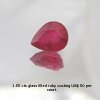 The ruby gemstone is next only to the diamond in terms of hardness and pricing. For a ruby to be born in the natural environment, a perfect combination of aluminum oxide, correct temperature, correct pressure in the earth’s crust and very low silicon content is a requisite. This makes rubies very rarely available gems in nature.
The ruby gemstone is next only to the diamond in terms of hardness and pricing. For a ruby to be born in the natural environment, a perfect combination of aluminum oxide, correct temperature, correct pressure in the earth’s crust and very low silicon content is a requisite. This makes rubies very rarely available gems in nature.
Ruby is one of the navagraha stones (stones that represent the nine planets that have a cosmic influence on all earthlings) representing the Sun (Ravi) and is related to our soul.
Rubies are considered a symbol of love and passion, thus making this gem as desirable today as it has been for centuries. This desire to own the exclusive “RED FIRE” makes it one of the most valuable gemstones in the market.
 Beliefs and legends about ruby mineral are many. It was called the 'ratnaraj', meaning, the king of all gemstones. It is believed that the person who possesses a good-quality ruby will live a life of peace and harmony. He or she would be protected against all danger & calamities, and would be blessed with good health, as the ruby wards off all evils. Legend and folklore say that if someone made an offering of ruby gems to Lord Krishna, they would be reborn as an emperor.
Beliefs and legends about ruby mineral are many. It was called the 'ratnaraj', meaning, the king of all gemstones. It is believed that the person who possesses a good-quality ruby will live a life of peace and harmony. He or she would be protected against all danger & calamities, and would be blessed with good health, as the ruby wards off all evils. Legend and folklore say that if someone made an offering of ruby gems to Lord Krishna, they would be reborn as an emperor.
Genuine ruby gemstones are said to enhance the status and bestow name, fame, virtue, vigor, warmth and commanding power to the wearer. They are also believed to eliminate depression in the wearer and make him bold and courageous. Women are discouraged from the regular use of rubies for it is believed to destroy body luster. The ruby aids in the cure of peptic ulcer, fever, rheumatism, and gout. For therapeutic purposes, the gem must be set in gold and worn in the ring finger.
 Composition Of Ruby Gemstone
Composition Of Ruby Gemstone The chemical composition of ruby gem is aluminum oxide (Al 2 O3). Its specific gravity is 3.99 to 4.00 and refractive index range is 1.760-1.768 to 1.770-1.779. Ruby’s hardness on Mohs scale is 9. It’s the next hardest mineral after diamond.
Ruby Gemstone belongs to the gemstone family of corundum. The most pure form of corundum is colorless, but presence of trace elements adds color to a corundum gem. The cause of color in ruby is chromium. Ruby is derived from a Latin word Ruber, which means red. However, the word corundum is derived from Hindu words Kurand or Kuruvinda.
Star Rubies
 These gems belong to the phenomenal corundum family. They show a star-like effect (called asterism) on the surface of the stone. For this star effect to be seen, the stone needs to be cut in a sphere-like cut called a cabochon cut. The star is formed by the intersection of three or more rays on the surface of the stone. The star effect is caused when the light reflects from the needle-like inclusion inside the stone. These needles are arranged intersecting each other in different directions.
These gems belong to the phenomenal corundum family. They show a star-like effect (called asterism) on the surface of the stone. For this star effect to be seen, the stone needs to be cut in a sphere-like cut called a cabochon cut. The star is formed by the intersection of three or more rays on the surface of the stone. The star effect is caused when the light reflects from the needle-like inclusion inside the stone. These needles are arranged intersecting each other in different directions.
A star ruby in which the star is distinct (in the center of the stone and uniform in size and shape) can fetch a good price in the market. Star rubies of fine quality can be very highly priced as well.
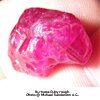 Ruby color
Ruby color
Ruby gems are found in a wide range of red like red, pinkish, purplish-brownish red and dark deep red. The finest of all these colors being the pigeon blood red gem found from the burmese mines, aptly known as burmese ruby.
Cut
 The cut of the ruby gemstone is not as important as other factors when it come to its pricing; however it is extremely important when it comes to get the best color. If the ruby is not cut and faceted in the correct crystal direction then a gemstone that would give a beautiful ruby red color may just give an ordinary color that will pull down the price drastically. It is a challenging task to get a good cut, for a gem with the best color and minimum wastage without compromising on the weight of this expensive gemstone.
The cut of the ruby gemstone is not as important as other factors when it come to its pricing; however it is extremely important when it comes to get the best color. If the ruby is not cut and faceted in the correct crystal direction then a gemstone that would give a beautiful ruby red color may just give an ordinary color that will pull down the price drastically. It is a challenging task to get a good cut, for a gem with the best color and minimum wastage without compromising on the weight of this expensive gemstone.
Carat
 The famous rubies found in the course of history of ruby are, the Chhatrapati Manick Ruby, an oval gem weighing 40 carats. Another is the Peace ruby of 43 carats found in 1919 (though it did not live up to its potential after cutting). The Edwards Ruby, which is 167 carats, is kept in the British Museum (Natural History Section) and is a large gem (though not of top quality). One of the finest Star Rubies on display would be at Smithsonian called the Rosser Reeves ruby from Sri Lanka, weighing 138.7 carats. There have been many large size rubies recorded in history; however such large sizes are extremely rare today. Thus as the carat size of the gem increases so does its price per carat.
The famous rubies found in the course of history of ruby are, the Chhatrapati Manick Ruby, an oval gem weighing 40 carats. Another is the Peace ruby of 43 carats found in 1919 (though it did not live up to its potential after cutting). The Edwards Ruby, which is 167 carats, is kept in the British Museum (Natural History Section) and is a large gem (though not of top quality). One of the finest Star Rubies on display would be at Smithsonian called the Rosser Reeves ruby from Sri Lanka, weighing 138.7 carats. There have been many large size rubies recorded in history; however such large sizes are extremely rare today. Thus as the carat size of the gem increases so does its price per carat.
Clarity
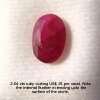 There is an entire range of the types and sizes of natural inclusions that are found in the natural ruby crystals. These are often typical to the mine that the gem comes from. The type of inclusion in the ruby makes it easy to identify the origin of the gem and thus affect its pricing. Broadly speaking, an included ruby will invariably fetch a lower price than a clearer ruby of the same color and size.
There is an entire range of the types and sizes of natural inclusions that are found in the natural ruby crystals. These are often typical to the mine that the gem comes from. The type of inclusion in the ruby makes it easy to identify the origin of the gem and thus affect its pricing. Broadly speaking, an included ruby will invariably fetch a lower price than a clearer ruby of the same color and size.
Ruby mines are found in Burma (now Myanmar), Thailand, Sri Lanka, South Africa, India, Afghanistan, Pakistan, Tanzania, Kenya, Nepal and Vietnam. A huge 90% of the world’s rubies come from Burma. Thailand buys a major portion of the Burmese gems and is the largest exporter of cut and treated rubies in the world today.
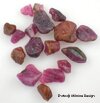 Treatments done on Ruby Gemstone
Treatments done on Ruby GemstoneTreatments are carried out on gemstone to lighten or darken the color or to improve the clarity and transparency, in order to fetch a better price for the stone in the market.
More than a 90% of the rubies found in the market today are treated to enhance their quality. However, it is ethically important for a dealer, to disclose the treatment done on the gemstones while trading. The most common treatment done on rubies is the heat treatment, in which, the ruby roughs are heated at a particular temperature in a furnace to improve their color.
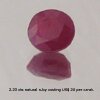 Another less acceptable treatment (of notorious reputation) is glass filling. This treatment involves the filling of fractures inside the ruby with so-called lead glass, which dramatically improves the transparency of the stone making a previously unsuited ruby, fit for use in expensive ruby jewelry, post treatment.
Another less acceptable treatment (of notorious reputation) is glass filling. This treatment involves the filling of fractures inside the ruby with so-called lead glass, which dramatically improves the transparency of the stone making a previously unsuited ruby, fit for use in expensive ruby jewelry, post treatment.
 Simulants
Simulants
There are frequent attempt made in the market to sell a ruby simulant falsely as a ruby. Synthetic rubies, which are difficult to tell apart from the natural genuine ruby to the naked eye, have also been present in the gemstone market from quite some time. Simulants like Spinel, tourmaline, zircon, garnet, kunzite, bixbite and synthetic ruby, if not examined using magnification can easily be mistaken for real rubies.
Ruby Jewelry
 Ruby gemstones are used extensively in jewelry in various shapes and sizes. Natural ruby ring is worn for astrological reasons specially in India. In south india ruby necklace, ruby bracelets and ruby earrings are liked by many. Ruby engagement rings are preferred by many these days to diamonds because of its rich color. Many designers design rings with dark red colored ruby in antique style and sell the same in market as antique ruby rings.
Ruby gemstones are used extensively in jewelry in various shapes and sizes. Natural ruby ring is worn for astrological reasons specially in India. In south india ruby necklace, ruby bracelets and ruby earrings are liked by many. Ruby engagement rings are preferred by many these days to diamonds because of its rich color. Many designers design rings with dark red colored ruby in antique style and sell the same in market as antique ruby rings.

The beautiful red-colored and the royal-blue-colored both belong to the same family of gemstones, corundum, and have the same chemical composition - aluminum oxide. The cause of color in ruby is chromium, while in sapphire is iron or titanium.
Ruby is the lucky birthstone for people born in the month of july. Hence it is also called as july birthstone. Ruby birthstones are used mostly in rings and pendants.
1) Webster
2) Gemmology by Peter G.Read
3) Handbook of Gem Identification - Richard T.Liddicoat, jr
4) Gems & Crystals - From the American Museum of Natural History - Anna S.Sofianides and George E.Harlow.
Home | Add URL | About Us | Contact Us | Links | Privacy Policy | Resources | Sitemap | Design by Paper Tree
Copyright 2007 GehnaBazaar.com. All rights reserved. The information contained in this webpage may not be published, broadcast, rewritten or redistributed without a prior written consent. Natural Gemstones | Precious Gemstones | Jewellery Designers | Jewelry Institutes | Jewelery Design Institutes | Gemstone Information | Diamond Information | Gemmological Laboratories | Gem Labs | Jewelry Articles | Gold Price | Jewel Store | Buy and Sell Jewellery | Jewery Classes | Deisgn classes | Gemologists | Diamond Price